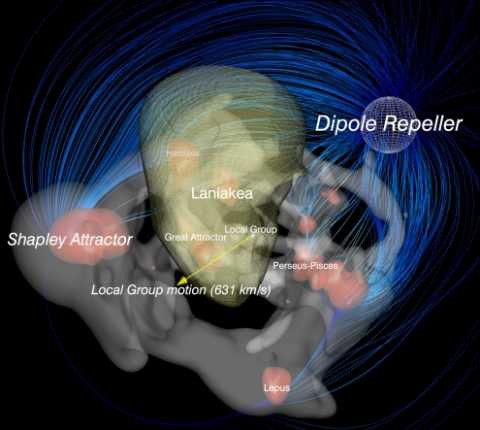By Ana Verayo, | February 02, 2017

Push and pull: Thus illustration shows the Shapley Attractor and the Dipole Reppeler.
Astronomers now suggest that the Milky Way galaxy is now being pushed towards another direction, deeper into the outer stretches of the cosmos and into a massive, cosmic void known as the "Dipole Repeller".
Our solar system is apparently traveling through space at 1.2 million miles per hour, pulling us and the Milky Way to the Great Attractor which is a gravitational anomaly that is dragging our home galaxy to a larger cosmic structure known as the Shapley Supercluster located some 650 million light years away.
Like Us on Facebook
However, this void is pushing us into the opposite direction. The solar system is located in one of the Milky Way's outer galactic spiral arms which is the opposite direction of the Great Attractor and Shapley Supercluster.
In a new study, a team discovered 800 new galaxies in that direction, by examining this specific part of the night sky. Now, a team from the Hebrew University of Jerusalem and an international team of scientists created a new 3D map of these colossal galactic structures known as the "galaxy flow field" that can track the direction of these galaxies, as they journey deeper into the universe.
With the help of data obtained from the Hubble Space Telescope, the astronomers focused on galaxies with erratic velocities or those that are moving faster than the expansion rate of the universe. Upon investigating and analyzing datasets, the team was able to determine the mass distribution across the universe, resulting in a model made of sparse regions of dark matter that can reject mass and highly dense regions of the most luminous galaxies that attract this mass.
With the help of this new model, astronomers were able to identify this void called the Dipole Repeller which is basically an expanse where there is an unusual lack of galaxy populations, that is ultimately repelling our Milky Way.
According to lead author of the study, Yehuda Hoffman from the Hebrew University of Jerusalem, when we have completed this 3D map of these flowing galaxies through space, we discovered how the Milky Way galaxy is speeding away from a large, previously unknown region of low density. He explains, since it repels matter rather than attracts, we have called this the Dipole Repeller.
Ultimately, the Milky Way is being pulled towards the Shapley Supercluster and is also pushed away by the newly detected Dipole Repeller. This study also emphasizes how these two massive cosmic forces have pushed our Milky Way to its current location.
Researchers also say that the Dipole Repeller is not completely empty, but it does possess a low number of galaxies, as further studies can examine these galaxies using infrared and radio wavelengths. This new study is published in the journal Nature Astronomy.
-
Use of Coronavirus Pandemic Drones Raises Privacy Concerns: Drones Spread Fear, Local Officials Say

-
Coronavirus Hampers The Delivery Of Lockheed Martin F-35 Stealth Fighters For 2020

-
Instagram Speeds Up Plans to Add Account Memorialization Feature Due to COVID-19 Deaths

-
NASA: Perseverance Plans to Bring 'Mars Rock' to Earth in 2031

-
600 Dead And 3,000 In The Hospital as Iranians Believed Drinking High-Concentrations of Alcohol Can Cure The Coronavirus

-
600 Dead And 3,000 In The Hospital as Iranians Believed Drinking High-Concentrations of Alcohol Can Cure The Coronavirus

-
COVID-19: Doctors, Nurses Use Virtual Reality to Learn New Skills in Treating Coronavirus Patients







